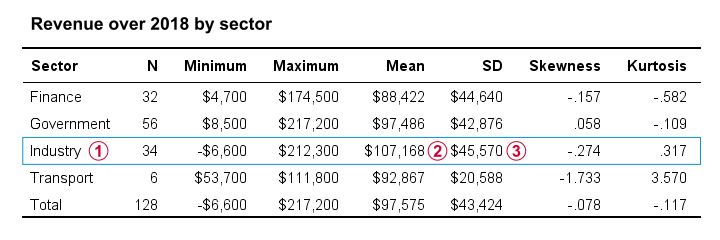
 SPSS TUTORIALS
SPSS TUTORIALS
 SPSS TUTORIALS
SPSS TUTORIALS

The vast majority of statistical tests fall into one of 6 basic types:
Look up which type of test is right for your data and you'll see which test you should use.
When analyzing data in SPSS, which steps should we take in which order?
This roadmap walks you through our basic data analysis routines -from inspecing and editing your data through your final tables, charts and tests.
This tutorial walks through running nice tables and charts for investigating the association between categorical or dichotomous variables. We'll demonstrate some cool SPSS tricks along the way.
This tutorial shows how to create nice tables and charts for studying the association between a dichotomous and a metric variable. If statistical assumptions are met, these may be followed up by an independent samples t test.
A previous tutorial introduced some summary statistics appropriate for both categorical as well as metric variables. Now it's time to turn to some measures that apply to metric variables exclusively. The most important ones are the mean (or average), variance and standard deviation.
When analyzing your data, you sometimes just want to gain some insight into variables separately. The first step in doing so is creating appropriate tables and charts. This tutorial shows how to do so for dichotomous or categorical variables.
This tutorial shows how to create nice tables and charts for comparing multiple dichotomous variables. We'll use some cool tricks for doing so.
This tutorial shows how to create nice tables and charts for comparing multiple categorical variables. This approach is suitable for variables having identical value labels and comparable contents.
This tutorial shows how to create proper tables and means charts for multiple metric variables. We'll use some cool tricks along the way for getting the most out of our output.
THIS TUTORIAL HAS 40 COMMENTS:
By Syed Sanowar Ali on April 25th, 2023
I want to learn more data analysis techniques
By Aman on June 17th, 2023
Hi it really nice
By Ayodeji Oluwayemi on July 12th, 2024
to more data analysis techniques
By Randall on September 23rd, 2024
What I find frustrating about all SPSS tutorials on EVERY site is the failure to expand to anything resembling real-world analytics.
Take the Explore procedure, using the EXAMINE command. I see MANY tutorials and NONE of them go beyond a single factor (or "BY" variable).
In life, we almost always want much further complexity than a single factor. E.g. Survey is fielded. If I want to look a particular item, I might be interested in a possible sex difference, race difference, age cohort difference. But? I'm also probably interested in looking the MIX of age AND sex, meaning did women ages 21-30 respond different than men ages 21-30...i.e. two factors, two BY variables - agecohort and sex.
I cannot find a SINGLE instance where ANY so-called tutorial delves beyond one sole BY variable and that just isn't answering real0-world situations.
So are two BY variables written var1 var2? Or....var1*var2? Or something else? I swear, nobody goes beyond the simplest case. I guess I'm the only SPSS user who has ever cut data by more than one single BY variable, i.e. one, single factor.
Wow.
By Ruben Geert van den Berg on September 23rd, 2024
Hi Randall, great comment!
First off, I cover multiple BY clauses in
-SPSS MEANS Command
-Two-Way ANOVA with Interaction Tutorial
-SPSS CROSSTABS Command
and probably some other (older) tutorials that I forgot about.
Another point is this: serious content creators need to make revenue and for this, they need large audiences.
Very sadly, such large audiences all want the same super basic (oftentimes useless) content such as normality tests and one-way ANOVA.
I've been -and still am- working hard to point out that there's really more interesting and useful topics (see our tools for example) but I just can't make a living by doing so.
So with regard to your complaint, I'd love to cover line charts (very useful for multiple BY variables) in detail but it'll hardly attract any visitors.
The problem really relates to the social sciences in general. There's tons of room for improvement. The vast majority of social "scientists" mess up their data analysis but nobody seems to really notice -let alone care.
Welcome to my world!